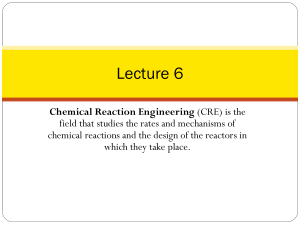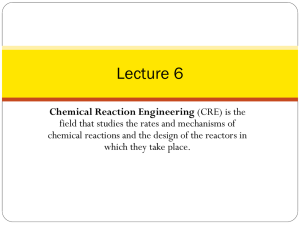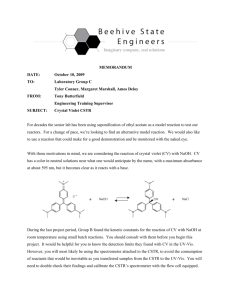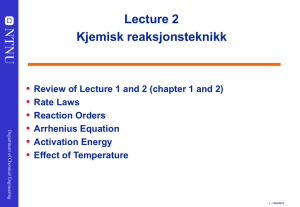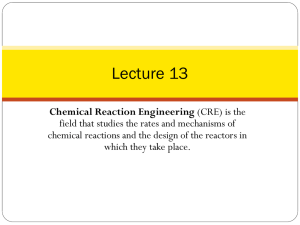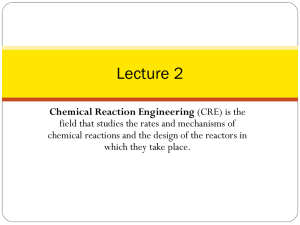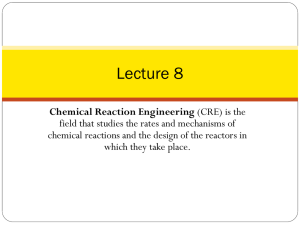Isothermal Reactor Design Part 1
advertisement
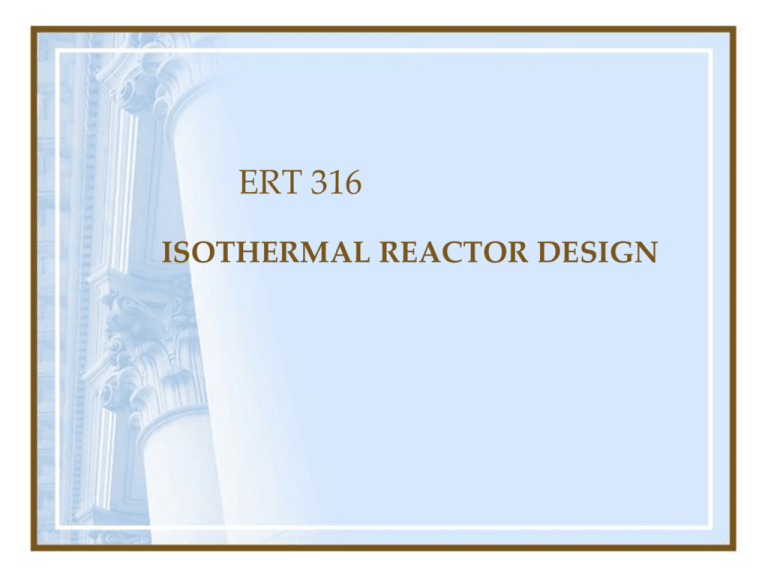
ERT 316 ISOTHERMAL REACTOR DESIGN START 1. The general mole equation Algorithm for Isothermal Reactor END 2. Design Equations: • Batch • CSTR • PFR YES 3. Is – rA=f(X) given? NO Evaluate the algebraic (CSTR) or integral (PFR) equations 4. Determine the rate law in terms of the concentration of the reacting species 5. Use Stoichiometry to express concentration as a function of conversion • Liquid phase or Gas phase • Constant Volume Batch • Constant P and T Copyright Cheng 05 6. Combine steps 4 and 5 to obtain –rA=f(X) 4.1 Design Algorithm for Isothermal Reactors • To design an isothermal reactors, the following sequence is highly recommended. 4.1 Design Algorithm for Isothermal Reactors • To carry out the evaluation, the following method can be used: Graphically (Chapter 2 plot) Numerical (Quadrature Formulas Chapter 2 and Appendix A4) Analytical (Integral Tables) Software (Polymath) Algorithm for isothermal Reactor (PFR reactor volume For 1st order gas-phase rxn Copyright Cheng 05 Scale up of Batch Reactor to the design of CSTR -scale up -pilot plant-costly -instead-build microplant(laboratory bench scale) -example: analyze data from a laboratory batch reactor-determine specific reaction rate, k-use it to design full-scale flow reactor Batch Operation - Calculation of time taken to achieve a given conversion X AB • Step 1: Write the mole balance dX N A0 rAV dt • Step 2: Write the rate law rA kCA2 Example for second order reaction • Step 3: Derive concentration term from stoichiometry C A C A0 1 X Batch Operation - Calculation of time taken to achieve a given conversion X AB • Step 4: Combine equation from step 1,2,3 dX 2 kCA0 1 X dt • Step 5: Evaluate t 1 0 dt kCA0 X dX 0 1 X 2 1 X t kCA0 1 X This is the reaction time or tR Algorithm to estimate reaction time Mole Balance Rate Law N A0 dX rAV dt R First order Second order rA kCA Stoichiometry Combine Evaluate (integrate) CA rA kCA2 NA C A0 1 X V0 dX k 1 X dt R tR 1 1 ln k 1 X dX 2 kCA0 1 X dt R 1 X tR kCA0 1 X Batch Operation - Calculation of time taken to achieve a given conversion X AB • To reach 90% conversion in a constant-volume batch reactor scales: tR 1 1 ln k 1 X 1 1 ln k 1 0.9 if k = 10-4 s-1 tR 2.3 23000s 6.4h 4 1 10 s For first order 4.2 Design of CSTR • Step 1: Write the mole balance of CSTR Design equation for CSTR is V FAO X v0C AO X (rA ) exit (rA ) exit If volumetric flow rate does not change with the reaction, (i.e. v = v0), then V v0C A0 X C A0 X t v0 rAv0 rA where t is the space time 4.2 Design of CSTR Step 2: Write the rate law • For 1st order irreversible reaction, rA kCA Step 3: Derive concentration in terms of conversion (from stoichiometry) C A C A0 1 X Step 4: Combine eq from step 1,2, 3 1 X t k 1 X Rearranging; tk X 1 tk tk is often referred to as Damköhler number (for 1st order) 4.2 Design of CSTR Step 2: Write the rate law • For 1st order irreversible reaction, rA kCA Step 3: Derive concentration in terms of conversion (from stoichiometry) C A0 C A C A0 1 X CA 1 tk Step 4: Combine eq from step 1,2, 3 1 X t k 1 X Rearranging; tk X 1 tk Damköhler number • Is the ratio of the rate of reaction of A to the rate of convective transport of A at the entrance to the reactor. rA0V Da rate of reaction at entrance entering flow rate of A FA0 • For first order irreversible reaction; r V kC V Da A0 A0 tk FA0 v0C A0 • For second order irreversible reaction; rA0V kCA2 0V Da tkCA0 FA0 v0C A0 How to estimate degree of conversion for a CSTR? • By using Damkohler number, rA0V Da FA0 If Da 0.1, X < 0.1 If Da 10, X > 0.9 If first degree order, Da = tk If second degree order, Da =tkCA0 Rule of thumb 4.2 Design of CSTR (for first order) • For CSTRs in series, conversion as a function of the number of tanks in series: 1 X 1 n (1 tk ) • For CSTRs in parallel, conversion is: tk X 1 tk Just like a single CSTR Example: Producing 200 Million Pounds per Year in a CSTR It is desired to produce 200 million pounds per year of ethylene glycol (EG). The reactor is to be operated isothermally. A 1lb mol/ft3 solution of ethylene oxide (EO) in water is fed to the reactor shown in figure together with an equal volumetric solution of water containing 0.9 wt% of the catalyst H2SO4. The specific reaction rate constant is 0.311 min-1 . (a) If 80% conversion is to be achieved, determine the necessary CSTR volume. (b) If 800-gal reactors were arranged in parallel, what is the corresponding conversion? (c) If 800-gal reactors were arranged in series, what is the corresponding conversion? A B catalyst C Example: Producing 200 Million Pounds per Year in a CSTR Extract the given information: FC = 2 x 108 lbm/yr x 1 yr/365 days x 1day/24 h x 1hr/60 min x 1lbmol/62lbm = 6.137 lbmol/min From reaction stoichiometry, FC = FA0X FA0 FC 6.137 lbmol 7.67 X 0.8 min Example: Producing 200 Million Pounds per Year in a CSTR STEP 1: Design equation of CSTR V FAO X ( rA ) exit STEP 2: Rate Law rA kCA STEP 3: Stoichiometry (Liquid phase, v = v0 ) C A C A0 1 X STEP 4: Combining; V FA0 X v0 X ( rA ) exit k (1 X ) Example: Producing 200 Million Pounds per Year in a CSTR v0VV STEP 5: Evaluate The entering volumetric flowrate of stream A, with CA01 = lb mol/ft3 before mixing is; v A0 FA0 7.67lbmol / min ft 3 7.67 3 C A01 1lbmol / ft min From the problem statement, vB 0 v A0 Thus, the total entering volumetric flow rate of liquid is v0 v A0 vB 0 ft 3 7.67 7.67 15.34 min Substituting all the values to calculate volume of reactor; FA0 X v0 X ft 3 0.8 3 V 15.34 197 . 3 ft (rA ) exit k (1 X ) min 0.311 min 1 1 0.8 Example: Producing 200 Million Pounds per Year in a CSTR b) CSTR in parallel. Rearranging the equation of volume in part a) v0 X k (1 X ) V X v0 k (1 X ) V t X k (1 X ) X tk Da (1 tk ) (1 Da ) tk X (1 X ) Example: Producing 200 Million Pounds per Year in a CSTR b) CSTR in parallel. X tk Da (1 tk ) (1 Da ) V 1 ft 3 1 t 800 gal 13.94 min 3 v0 7.48 gal 7.67 ft / min Da tk 13.94 min 0.311 min 1 4.34 X 4.34 0.81 (1 4.34) Example: Producing 200 Million Pounds per Year in a CSTR c) CSTR in series 1 X 1 (1 tk ) n V 1 ft 3 1 t 800 gal 6.97 min 3 v0 7.48 gal 15.34 ft / min Da tk 6.97 min 0.311 min 1 2.167 1 X 1 0.90 2 1 2.167 4.3 PFR • Assume no dispersion and no radial gradients in either temperature, velocity, or concentration and in the absence of pressure drop or heat exchange. STEP 1: Write the mole balance of PFR: X dX V FA0 rA 0 STEP 2: Write the rate law Eg: For second order, rA kC 2 A 4.3 PFR STEP 3: Write concentration in terms of conversion (from stoichiometry) C A C A0 1 X For liquid phase 1 X C A C A0 1 x For gas phase 4.3 PFR STEP 4: Combine all the equations F V A20 kCA0 v0 X dX 0 1 X 2 kCA0 1 X X Rearranging, X FA0 V 2 kCA0 v 0 kCA0 For liquid phase tkCA0 Da 2 1 tkCA0 1 Da 2 1 X 2 dX 0 1 X 2 X (1 ) 2 X 2 2 (1 ) ln( 1 X ) X 1 X For gas phase Design a PFR: summary In case of 2nd order rxn, liquid phase, isothermal dX FA0 rA dV • mole balance No pressure drop No heat exchange V FA0 X 0 dX rA rA kCA2 • rate laws C A C A0 (1 X ) • Stoichiometry FA0 V 2 kCA0 • combination or X 0 v0C A0 X dX 2 2 1 X kCA0 1 X tkCA0 Da 2 X 1 tkCA0 1 Da 2 Damköhler number for 2nd-order reaction Design a PFR: summary In case of 2nd order rxn, gas phase, isothermal • mole balance • rate laws • Stoichiometry • combination dX FA0 rA dV No pressure drop No heat exchange V FA0 X 0 dX rA rA kCA2 FA0 (1 X ) FA FA (1 X ) CA C A0 v v0 (1 X ) v0 (1 X ) (1 X ) 2 1 X V FA0 dX 2 2 0 kCA0 1 X X v0 V kCA0 2 1 X 2 2 (1 ) ln( 1 X ) X 1 X
